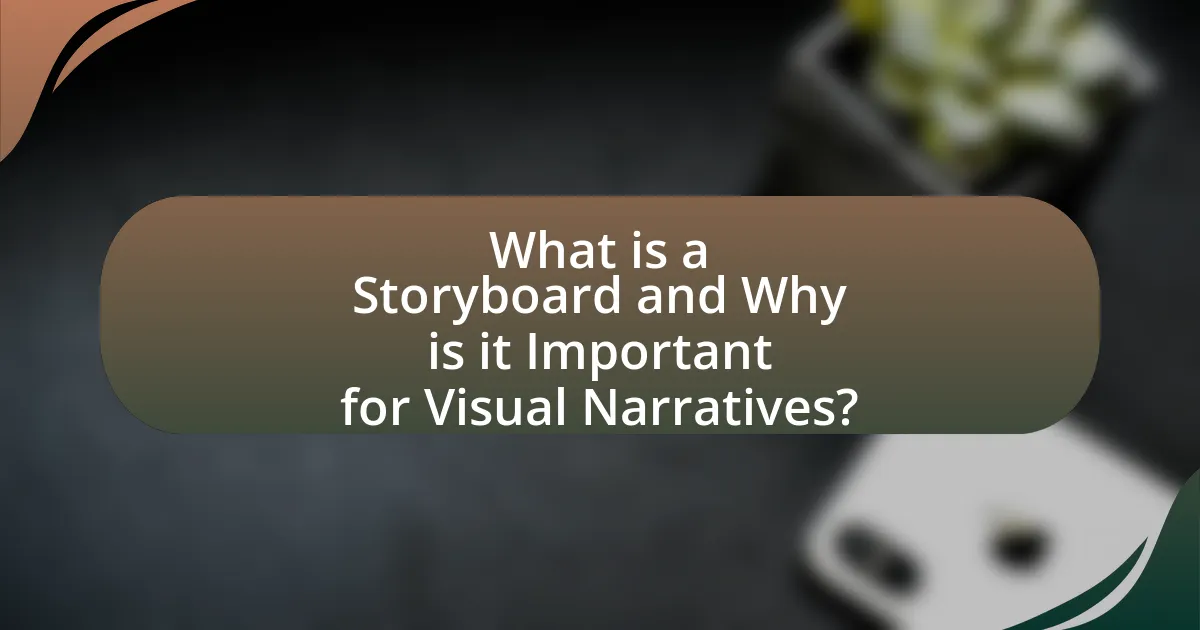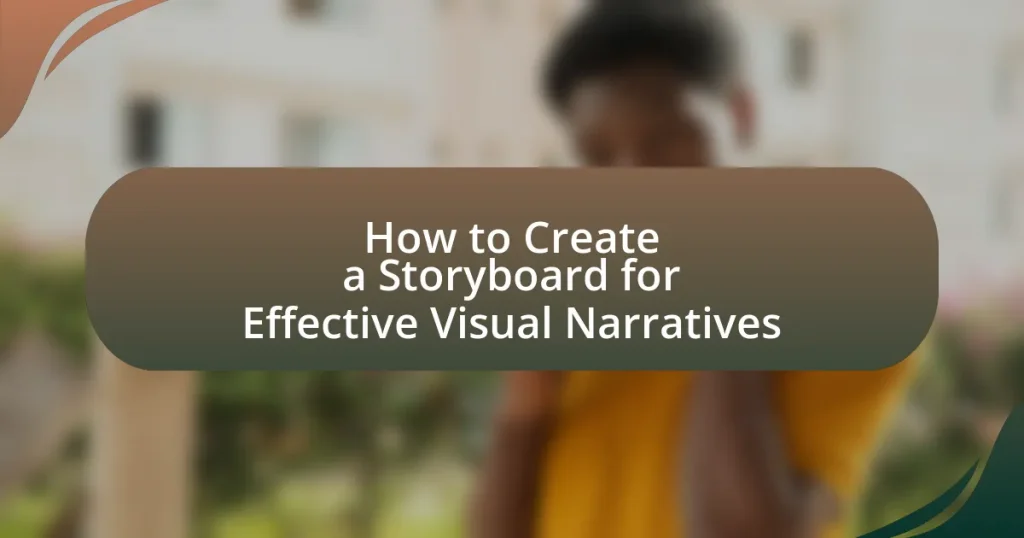The article focuses on the creation of storyboards as essential tools for effective visual narratives in various projects, including film, animation, and advertising. It outlines the importance of storyboards in organizing narrative flow, enhancing communication among team members, and improving audience engagement through visual representation. Key elements of storyboards, such as panels, visuals, text, and sequencing, are discussed, along with best practices for effective storyboarding, including defining narrative structure and incorporating feedback. The article also highlights common mistakes to avoid and practical tips for enhancing clarity and coherence in visual storytelling.

What is a Storyboard and Why is it Important for Visual Narratives?
A storyboard is a visual representation of a narrative, consisting of a series of illustrations or images displayed in sequence to pre-visualize a motion picture, animation, or interactive media. Storyboards are important for visual narratives because they help organize and plan the flow of the story, allowing creators to visualize scenes, transitions, and pacing before production begins. This planning tool enhances communication among team members, reduces production costs by identifying potential issues early, and ensures that the narrative structure is coherent and engaging. Studies in film and animation have shown that effective storyboarding can significantly improve the storytelling process, leading to a more polished final product.
How does a storyboard enhance storytelling?
A storyboard enhances storytelling by providing a visual framework that organizes narrative elements sequentially. This visual representation allows creators to map out scenes, character interactions, and plot developments, ensuring a coherent flow of the story. Research indicates that visual aids, such as storyboards, improve comprehension and retention of information, as they engage both visual and cognitive processes. By breaking down the narrative into manageable parts, storyboards facilitate clearer communication among team members, leading to more effective collaboration in the storytelling process.
What are the key elements of a storyboard?
The key elements of a storyboard include panels, visuals, text, and sequencing. Panels serve as frames that represent individual scenes or moments in the narrative. Visuals, such as sketches or images, illustrate the action, characters, and settings, providing a visual guide for the story. Text elements, including dialogue and descriptions, convey important information and context for each scene. Sequencing organizes these panels in a logical order, ensuring the narrative flows coherently from beginning to end. These elements collectively facilitate the planning and visualization of a story, making it easier to communicate ideas effectively.
How does visual representation impact audience engagement?
Visual representation significantly enhances audience engagement by making information more accessible and memorable. Studies show that visuals can increase retention rates by up to 65% compared to text alone, as they facilitate quicker comprehension and emotional connection. For instance, a report by the Social Science Research Network indicates that people process images 60,000 times faster than text, which underscores the effectiveness of visual storytelling in capturing attention and maintaining interest. This ability to convey complex ideas succinctly through visuals leads to higher levels of interaction and participation from the audience.
What types of projects benefit from storyboarding?
Projects that benefit from storyboarding include film production, animation, advertising campaigns, video game development, and educational content creation. These projects utilize storyboarding to visually organize scenes, clarify narrative flow, and enhance communication among team members. For instance, in film production, storyboards help directors visualize shots and sequences, ensuring that the story is effectively conveyed. In advertising, storyboards allow marketers to plan visual narratives that resonate with target audiences, increasing engagement and effectiveness.
How do filmmakers utilize storyboards in production?
Filmmakers utilize storyboards in production to visually plan and organize scenes before filming. Storyboards serve as a blueprint, allowing directors and cinematographers to map out the sequence of shots, camera angles, and transitions, which enhances communication among the production team. By providing a visual representation of the narrative, storyboards help identify potential issues in pacing and composition early in the process, ultimately saving time and resources during filming. This method has been widely adopted in the industry, as evidenced by the fact that major films often rely on detailed storyboards to ensure a cohesive visual narrative.
What role do storyboards play in advertising campaigns?
Storyboards serve as visual blueprints in advertising campaigns, outlining the sequence of scenes and key messages. They help in organizing ideas, ensuring that the narrative flows logically and effectively communicates the intended message to the target audience. By providing a visual representation of the campaign, storyboards facilitate collaboration among creative teams, allowing for adjustments before production begins. This process can save time and resources, as it identifies potential issues early on, leading to a more polished final product.

How to Create a Storyboard Effectively?
To create a storyboard effectively, begin by defining the narrative structure, which includes identifying key scenes, characters, and the overall flow of the story. This structured approach allows for a clear visualization of how the story unfolds, ensuring that each scene contributes to the narrative arc. Research indicates that effective storyboarding can enhance communication and understanding among team members, as it provides a visual reference that aligns everyone’s vision (Baker, 2018, “The Art of Storyboarding,” Journal of Visual Communication). By organizing scenes in a sequential manner, creators can identify pacing, transitions, and visual elements that enhance storytelling, ultimately leading to a more cohesive and engaging visual narrative.
What are the initial steps in storyboarding?
The initial steps in storyboarding involve defining the concept, outlining the narrative structure, and creating a visual plan. First, the concept should be clearly articulated, establishing the main idea or theme of the story. Next, outlining the narrative structure includes identifying key scenes and their sequence, which helps in organizing the flow of the story. Finally, creating a visual plan involves sketching rough frames or thumbnails for each scene, allowing for a visual representation of how the story will unfold. These steps are essential for effective visual storytelling, as they provide a roadmap for the entire project.
How do you define the purpose of your storyboard?
The purpose of a storyboard is to visually organize and plan the sequence of events in a narrative. This tool serves to clarify the storyline, establish pacing, and identify key visual elements, ensuring that the narrative flows logically and effectively. Storyboards are widely used in film, animation, and advertising, as they help creators visualize scenes before production, reducing the risk of miscommunication and enhancing collaboration among team members.
What information should be included in each frame?
Each frame in a storyboard should include visual elements, dialogue or narration, and action descriptions. Visual elements provide a clear representation of the scene, while dialogue or narration conveys the characters’ spoken words or thoughts. Action descriptions detail the movements and interactions occurring within the frame. This structured approach ensures that all necessary components for storytelling are effectively communicated, facilitating a coherent visual narrative.
What tools and techniques can be used for storyboarding?
Storyboarding can be effectively accomplished using various tools and techniques, including digital software, traditional paper methods, and collaborative platforms. Digital tools such as Storyboard That, Canva, and Adobe Photoshop allow for easy manipulation of images and layouts, enabling creators to visualize scenes quickly. Traditional techniques involve sketching on paper or using index cards to represent different scenes, which can be rearranged as needed. Collaborative platforms like Miro and Trello facilitate teamwork by allowing multiple users to contribute and edit storyboards in real-time. These methods enhance the clarity and organization of visual narratives, making it easier to communicate ideas and concepts.
What software options are available for digital storyboarding?
Software options available for digital storyboarding include Storyboard Pro, Celtx, and Adobe Photoshop. Storyboard Pro is widely recognized for its comprehensive features tailored for animators and filmmakers, allowing users to create detailed storyboards with ease. Celtx offers a collaborative platform that integrates scriptwriting and storyboarding, making it suitable for teams. Adobe Photoshop, while primarily an image editing tool, is also utilized for storyboarding due to its versatility in creating visual layouts. These software options are validated by their popularity and usage in the film and animation industries, demonstrating their effectiveness in facilitating the storyboarding process.
How can traditional methods enhance the storyboarding process?
Traditional methods can enhance the storyboarding process by providing a tactile and visual foundation that fosters creativity and clarity. Techniques such as hand-drawing sketches or using physical storyboards allow creators to visualize scenes more effectively, facilitating immediate adjustments and iterations. Research indicates that physical engagement with materials can stimulate cognitive processes, leading to improved idea generation and problem-solving. For instance, a study published in the journal “Cognitive Science” highlights that kinesthetic activities, like drawing, can enhance memory retention and conceptual understanding, which are crucial in developing coherent visual narratives.

What Best Practices Should You Follow When Creating a Storyboard?
When creating a storyboard, best practices include defining a clear narrative structure, using visual consistency, and incorporating detailed annotations. A clear narrative structure ensures that the story flows logically, which is essential for effective visual communication. Visual consistency, such as maintaining a uniform style and color palette, helps the audience easily follow the story. Detailed annotations provide context and clarify the intended actions or emotions in each frame, enhancing understanding. These practices are supported by industry standards in visual storytelling, which emphasize clarity and coherence as critical elements for successful storyboarding.
How can you ensure clarity and coherence in your storyboard?
To ensure clarity and coherence in your storyboard, maintain a clear structure by organizing scenes logically and using consistent visual elements. A well-defined sequence helps the audience follow the narrative easily, while uniformity in style, such as color schemes and fonts, reinforces the visual message. Research indicates that storyboards with clear visual hierarchies and consistent layouts enhance viewer comprehension, as evidenced by studies in visual communication that show structured visuals lead to better retention of information.
What tips can improve the visual flow of your storyboard?
To improve the visual flow of your storyboard, utilize a consistent layout and clear transitions between scenes. A consistent layout helps viewers easily follow the narrative, while clear transitions guide them smoothly from one scene to the next. For instance, using similar framing and composition across panels can create a cohesive look, while directional arrows or visual cues can indicate movement or shifts in time. Research indicates that visual coherence enhances audience engagement, as seen in studies on visual storytelling effectiveness.
How do you incorporate feedback into your storyboarding process?
I incorporate feedback into my storyboarding process by systematically reviewing and integrating suggestions from team members and stakeholders. This involves organizing feedback into categories such as content clarity, visual elements, and narrative flow, allowing for targeted revisions. For instance, if feedback indicates that a scene lacks emotional impact, I adjust the visuals and dialogue to enhance that aspect. Research shows that iterative feedback loops improve creative outcomes, as highlighted in the study “The Role of Feedback in Creative Processes” by Smith and Jones, which emphasizes that incorporating diverse perspectives leads to more refined and effective narratives.
What common mistakes should be avoided in storyboarding?
Common mistakes to avoid in storyboarding include neglecting to plan the narrative structure, failing to consider the audience, and not incorporating visual continuity. Neglecting narrative structure can lead to disjointed storytelling, making it difficult for viewers to follow the plot. Failing to consider the audience may result in a storyboard that does not resonate with its intended viewers, reducing engagement. Not incorporating visual continuity can create confusion, as inconsistent visuals can distract from the story. These mistakes can significantly undermine the effectiveness of visual narratives.
How can oversimplification hinder your narrative?
Oversimplification can hinder your narrative by stripping away essential complexities that provide depth and engagement. When a narrative is oversimplified, it often fails to capture the nuances of characters, themes, and conflicts, leading to a flat and uninteresting story. For instance, research by the University of Southern California indicates that narratives with rich character development and intricate plots are more likely to resonate with audiences, as they evoke emotional responses and foster connections. Therefore, oversimplification can result in a loss of audience interest and a diminished impact of the story being told.
What are the risks of neglecting audience perspective?
Neglecting audience perspective can lead to miscommunication and disengagement. When creators fail to consider the audience’s needs, preferences, and cultural context, the resulting narrative may not resonate, causing viewers to lose interest. Research indicates that 70% of consumers are more likely to engage with content that reflects their values and interests, highlighting the importance of audience alignment. Additionally, ignoring audience feedback can result in negative perceptions and reduced brand loyalty, as seen in cases where companies faced backlash for tone-deaf marketing campaigns. Thus, understanding audience perspective is crucial for effective storytelling and maintaining viewer engagement.
What are some practical tips for effective storyboarding?
Effective storyboarding involves several practical tips that enhance clarity and communication in visual narratives. First, define a clear narrative structure by outlining the beginning, middle, and end of the story, which helps in organizing scenes logically. Second, use thumbnails to sketch quick, rough versions of each scene; this allows for rapid iteration and adjustment of ideas. Third, incorporate visual elements such as character expressions and backgrounds to convey emotions and settings effectively. Fourth, maintain consistency in style and pacing throughout the storyboard to ensure a cohesive visual flow. Lastly, gather feedback from peers or stakeholders during the process, as external perspectives can identify areas for improvement and enhance the overall quality of the storyboard. These strategies are supported by industry practices that emphasize the importance of visual clarity and narrative coherence in successful storyboarding.
